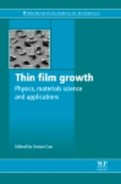Table of Contents
Part I: Theory of thin film growth
Chapter 1: Measuring nucleation and growth processes in thin films
1.2 Basic theory of epitaxial growth
1.3 Observation method of atomic steps
1.4 Two-dimensional-island nucleation and step-flow growth modes
1.5 The motion of atomic steps on a growing and evaporating Si(111) surface
1.6 Morphological instability of atomic steps
1.7 Conclusion and future trends
Chapter 2: Quantum electronic stability of atomically uniform films
2.3 Angle-resolved photoemission spectroscopy
2.5 Quantum thermal stability of thin films
2.6 General principles of film stability and nanostructure development
2.7 Beyond the particle-in-a-box
Chapter 3: Phase-field modeling of thin film growth
Chapter 4: Analysing surface roughness evolution in thin films
4.2 Roughness during homo-epitaxial growth
4.3 Roughness during hetero- or non-epitaxial growth
Chapter 5: Modelling thin film deposition processes based on real-time observation
5.1 Introduction: time resolved surface science
5.3 Experimental techniques for real-time and in-situ studies
5.6 Sources of further information and advice
Part II: Techniques of thin film growth
Chapter 6: Silicon nanostructured films grown on templated surfaces by oblique angle deposition
6.2 Preparation of templated surface for oblique angle deposition
6.3 Fan-out on templated surface with normal incident flux
6.4 Fan-out growth on templated surfaces with oblique angle incident flux
6.5 Control of fan-out growth with substrate rotations
6.6 Applications and future trends
Chapter 7: Phase transitions in colloidal crystal thin films
7.3 Description of colloidal crystal phases: historical survey
7.4 Phase transition sequence in colloidal crystal thin films
7.5 Conclusions and future trends
8.2 Deposition of stoichiometric Cu3N
8.4 Doping of Cu3N by co-sputtering
Chapter 9: Growth of graphene layers for thin films
9.2 Large-scale pattern growth of graphene films for stretchable transparent electrodes
9.3 Roll-to-roll production of 30-inch graphene films for transparent electrodes
Chapter 10: Epitaxial growth of graphene thin films on single crystal metal surfaces
10.2 Structure of graphene on metals
10.3 Growth of graphene on a metal
10.5 Sources of further information and advice
Chapter 11: Electronic properties and adsorption behaviour of thin films with polar character
11.1 Introduction to oxide polarity
11.3 Measuring polarity of thin oxide films
11.4 Adsorption properties of polar films
11.5 Conclusion and future trends
11.6 Sources of further information and advice
Chapter 12: Polarity controlled epitaxy of III-nitrides and ZnO by molecular beam epitaxy
12.2 Lattice polarity and detection methods
12.3 Polarity issues at heteroepitaxy and homoepitaxy
12.4 Polarity controlled epitaxy of GaN and AlN
12.5 Polarity controlled epitaxy of InN
12.6 Polarity controlled epitaxy of ZnO
Chapter 13: Understanding substrate plasticity and buckling of thin films
13.2 Experimental observations
Chapter 14: Controlled buckling of thin films on compliant substrates for stretchable electronics
14.2 Mechanics of one-dimensional non-coplanar mesh design
14.3 Mechanics of two-dimensional non-coplanar mesh design
Chapter 15: The electrocaloric effect (ECE) in ferroelectric polymer films
15.2 Thermodynamic considerations on materials with large electrocaloric effect (ECE)
15.3 Previous investigations on electrocaloric effect (ECE) in polar materials
15.4 Large electrocaloric effect (ECE) in ferroelectric polymer films
Chapter 16: Network behavior in thin films and nanostructure growth dynamics
